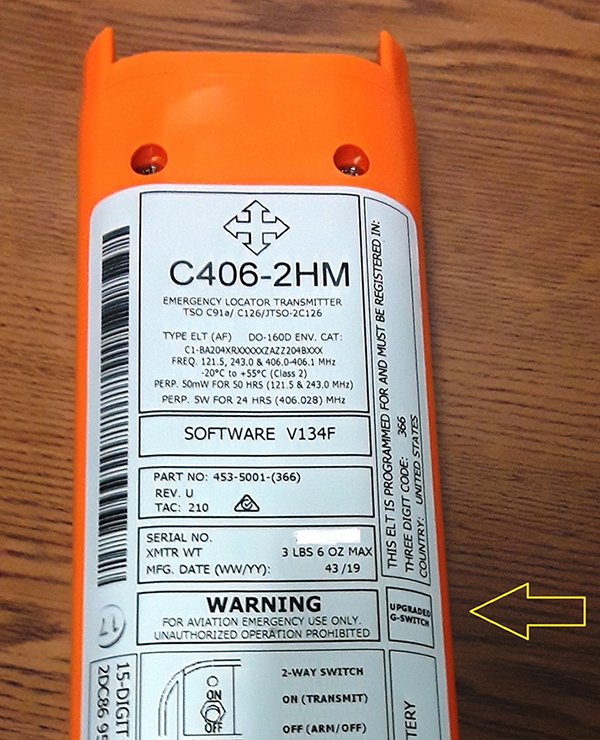 will be closed December 24th - January 2nd for the Holidays.
will be closed December 24th - January 2nd for the Holidays.
Regular business hours will resume on Monday, January 5th.
AOG Services are available.
| Part #: | |
|---|---|
| Model: | G406-4 |
| Desc: | ELT w/ 110-324 and 110-329 Whip Antenna |
| OEM: | ACR/Artex |
| NSN: | |
|---|---|
| Sched-B: | 8525508040 |
| ECCN: |
 Select part number above to view pricing and availability.
Select part number above to view pricing and availability.
| Price | Condition | Availability | Stock Info | |
|---|---|---|---|---|
| Price | Cond. | Avail. | Stock Info | |
| $6,675.00 | NEW OUTRIGHT | REQUEST LEAD TIME |
|
| Price | Condition | Availability | Stock Info | |
|---|---|---|---|---|
| Price | Cond. | Avail. | Stock Info | |
| REQUEST | NEW OUTRIGHT | REQUEST LEAD TIME |
|
| Price | Condition | Availability | Stock Info | |
|---|---|---|---|---|
| Price | Cond. | Avail. | Stock Info | |
| $9,980.00 | NEW OUTRIGHT | REQUEST LEAD TIME |
|
| Price | Condition | Availability | Stock Info | |
|---|---|---|---|---|
| Price | Cond. | Avail. | Stock Info | |
| $6,695.00 | NEW OUTRIGHT | REQUEST LEAD TIME |
|

In order to ship hazardous materials (HAZMAT) the shipper must have HAZMAT certified personnel. SEA will provide HAZMAT paperwork along with proper packaging and labeling for shipments directly to our customers. If the shipment must be sent to another location such as a freight forwarder, SEA will provide the HAZMAT paperwork to the original ship to address only. Please contact your freight forwarder prior to ordering to verify that they are HAZMAT certified. SEA is not responsible for issues that arise if your freight forwarder does not have HAZMAT qualified personnel.
SPECIFICATIONS
| Dimensions: | 11.74"L x 3.90"H x 3.82"W | Weight: | 3lb 5.8oz |
| Operating Frequencies: | 406.025MHz +/- 2kHz Biphase L 121.5 & 243.0MHz +/- 0.005% | Output Power: | 406MHz: 5 W +/- 2dB for 24hrs @ -20C 121.5/243.0MHz: 100mW min |
| Activation: | Automatic by 4.5ft/sec G-Switch or Manual | Battery: | 5yr Lithium |
| Temperature: | Operating: -20C to +55C Storage: -55C to +85C | Remote Control: | On/Off/Reset |
| Antenna: | Rod (110-320) (<350KTS) Whip Antenna Configuration requires use of 2 antennas: Whip (110-324) (121.5/243Mhz Whip (110-329) (406MHz<250KTS) |
| Part Number: | Description: |
|---|---|
| 453-5012 | ELT w/ 110-324 and 110-329 Whip Antenna, Transmitter Only (Main Assembly) |
| 455-5018* | ELT Base Pack List - contains transmitter & mounting hardware |
| 455-5019* | Complete ELT System with Rod Antenna (110-320) |
| 455-5044* | Complete ELT System with 2 Whip Antennas (110-324 w/inductor & 110-329) |
* Please Note that the Attached "Pack Lists" are for REFERENCE ONLY & are subject to change.
| Price | Condition | Status |
|---|---|---|
| $6,675.00 | NEW OUTRIGHT | REQUEST LEAD TIME |
| Price | Condition | Status |
|---|---|---|
| REQUEST | NEW OUTRIGHT | REQUEST LEAD TIME |
| Price | Condition | Status |
|---|---|---|
| $9,980.00 | NEW OUTRIGHT | REQUEST LEAD TIME |
| Price | Condition | Status |
|---|---|---|
| $6,695.00 | NEW OUTRIGHT | REQUEST LEAD TIME |
Click on a question below to see the answer. If you have a question about this model that is not answered below, please contact questions@seaerospace.com
Long messaging transmits longtitude and latitude. Short messaging does not.
In relation to NE (New) parts, many OEMs change their prices and availability without any notice to dealers or the industry. Therefore, through the REQUEST or RFQ indication, we ask that customers contact us for the most accurate price and availability.
In relation to SV & OH parts, the used parts aftermarket in the aviation industry is not an infinite supply. It is a dynamic, constantly changing market that is significantly affected by and susceptible to highs and lows in supply and demand. Therefore, although we attempt to, at times, we are unable to predict the exact moment when an item may be available. Once again, through the REQUEST or RFQ indication on our website, we ask that customers contact us for the most current and accurate price and availability.
The only indication that new ACR/Artex ELTs have the upgraded G-switch as detailed in SB1000 is the "UPGRADED G-SWITCH" box on the identification plate. Please see image for reference.


 . These Russian words translate to "Space System for the Search of Vessels in Distress".
. These Russian words translate to "Space System for the Search of Vessels in Distress".